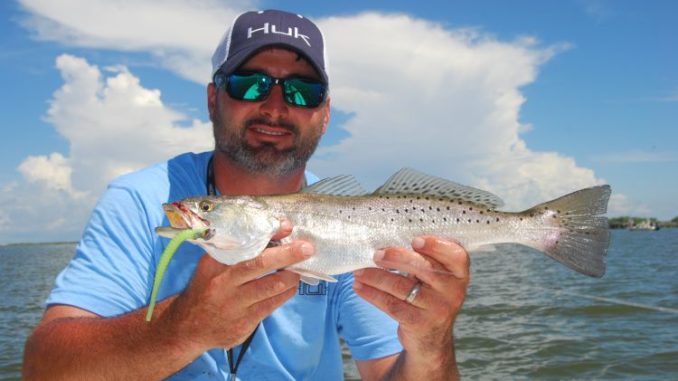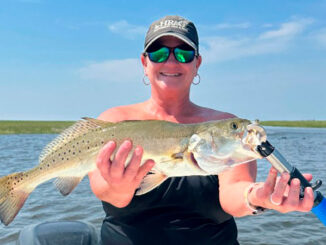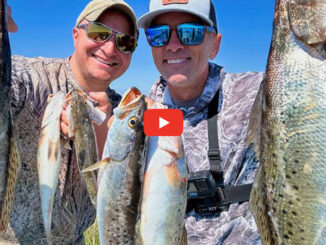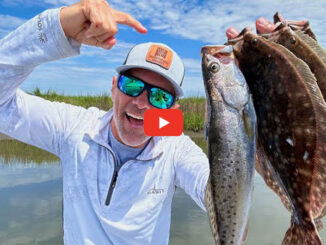
Z-Man’s Swimmin’ TroutTrick lure lasts all day, guide says
Capt. Ross Montet had a great trip out to Breton Island late last week, easily bringing back four limits of speckled trout on a day when the fish smashed lures as soon as they hit the water, seemingly on just about every cast.
But Montet, with Cajun Fishing Adventures in Buras, knows the fickle nature of Breton Island doesn’t always guarantee such success.
“It can be feast or famine,” said Montet, who guided the big trip Friday during the 2016 Buras Marsh Media Bash, an annual four-day event held for fishing industry media and vendors hosted by Capt. Ryan Lambert. “You can get out there and smoke them, and go out there the next day and not catch a fish.
“I’ve done that — that’s just how it is.”
When he does make the 45-mile round trip run from Buras out to Breton Island, Montet tries to plan around fishing an incoming tide.
“An incoming tide is always great in any trout-fishing situation,” he said. “The last three or four hours of an incoming tide and the start of the fall typically is the best time to fish, so you can plan your trip around that.”
Being a creature of habit, Montet said he always fishes the cove-side of Breton first, starting about 150 yards from the old pier — a recognizable landmark on what remains of the island.
“Typically you’ll catch fish approaching, so I try to drift into it if there’s not too many boats,” he said. “But normally, on Saturday it’s not uncommon to see 20 or 30 boats out there. But just drift into it if you can and fish all the way in.
“I try to start on the right-hand side coming in and work my way left.”
The eddy created in the cove typically holds trout, which are attracted to the abundance of bait there.
“You can fish live bait, but I find I have better success with artificials,” Montet said. “You get to dealing with ladyfish, catfish, sail cats and needlefish. You know how live bait is: It’s 50 cents a shrimp and you’re always hooking up with something — but it might not be what you want.”
Instead, he goes with Z-Man soft plastics like Swimmin’ TroutTricks or original TroutTricks on a ¼-ounce jighead.
“The Z-Man lures are huge,” he said. “Find the right color, superglue it to the jighead and you can fish that bait the whole day.”
He said to experiment with your retrieve to find out what the trout like on that particular trip.
“Last summer, we got out there and we tried traditional jigging — twitch, twitch, pop — and it wasn’t doing it. It ended up being like a wintertime pattern, where we had to throw it out, let it go to the bottom and slowly retrieve it back, and I was catching good fish like that,” he said. “This year, the fish were in the upper part of the water column, and if they didn’t hit it as soon as it hit the water, you almost had to burn it coming in to get a bite.”
Montet said he always uses a small — 1- to 2-foot — leader of Seaguar Premier flurocarbon attached to Smackdown Tournament Braid with an Albright knot.
“Some days the water is really clean out there, so it’s important to put a 20- or 30-pound leader on the braid,” he said. “For the most part, I don’t ever tie a 4- or 5-foot leader. I only do a foot or maybe 2 feet at most so I can stop it right at the tip of the rod where the knot is and still cast it.”
If the cove isn’t producing, Montet swings around and works the beach to see if he can find trout in the troughs. He typically stays about 75 yards off the beach, and casts both parallel to, and into the surf, with Z-Man plastics.
“If the water is clean, you’ll see it lighten and then it will darken up,” he said. “Make your cast to those dark spots — those are the troughs, and that’s deeper water.
“That water is cooler in the summertime, so those fish get down in those troughs. It’s like a highway for bait, and it funnels current through there.”
If past history is any indication, trout could be holding there for about another three weeks, give or take. Montet said the specks typically stay on Breton Island until September’s full moon, which occurs on Sept. 16 this year.
“September is typically the transition month when they start coming back in,” he said. “The water temperature will be coming down, and hopefully we’ll be getting our first few cool fronts, if we’re lucky.
“But full moons are pretty much a key factor for when these fish start moving.”


